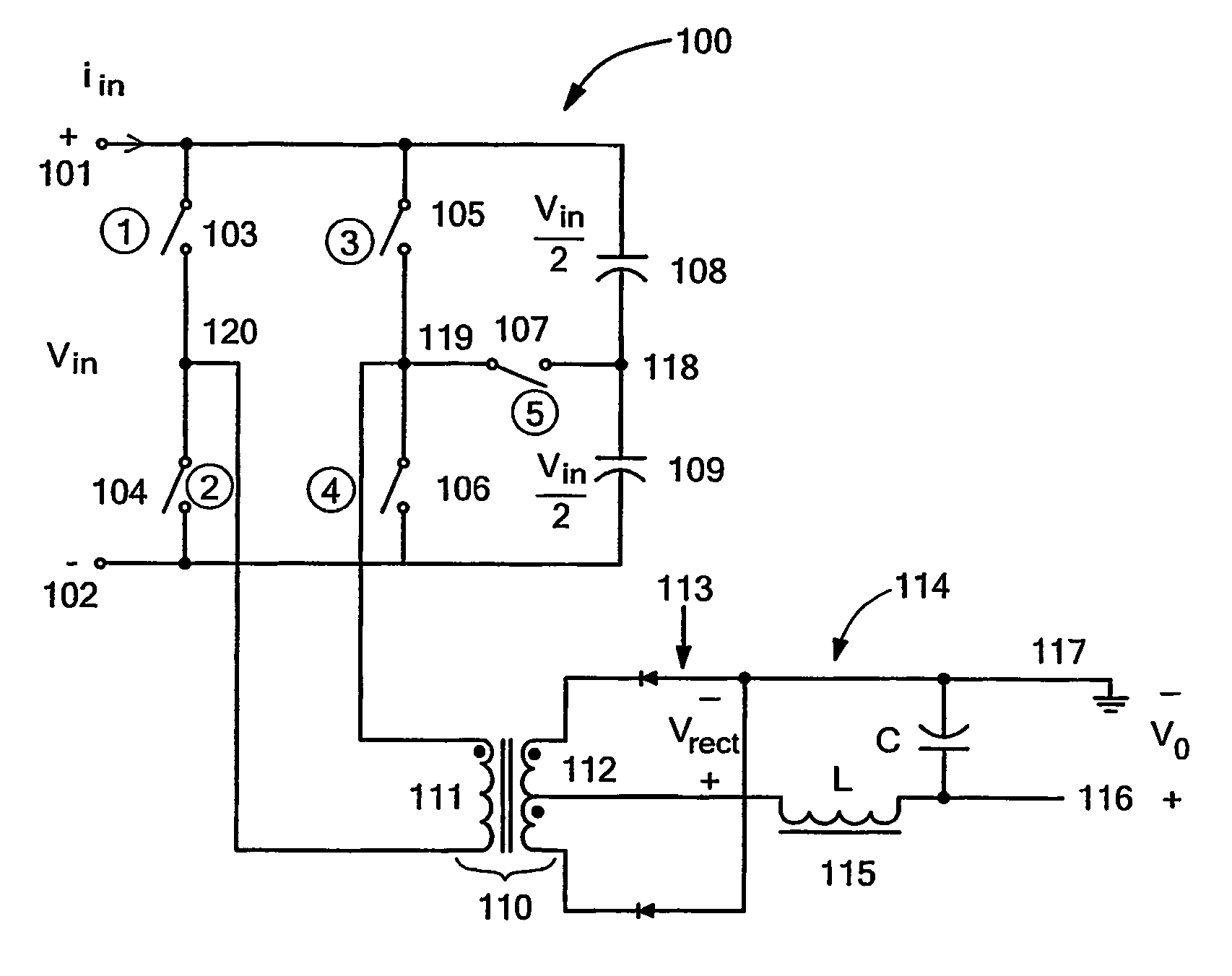Dc-dc converters providing reduced deadtime
- Summary
- Abstract
- Description
- Claims
- Application Information
AI Technical Summary
Benefits of technology
Problems solved by technology
Method used
Image
Examples
embodiment 300
FIG. 3a depicts an alternative embodiment 300 of the DC-DC converter 100 of FIG. 1. It is noted that the ideal switching elements 103-107 of the converter100 are replaced in the DC-DC converter 300 by non-ideal MOSFET switching elements 303-307, respectively. Each of the MOSFETs 303-307 is depicted in FIG. 3a with its inherent body diode to indicate the direction of its current blocking capability when turned off. It is understood that any other suitable components may be employed for the switching elements 303-307. The DC-DC converter 300 is configured so that the switching element 107 can be controlled bi-directionally. As shown in FIG. 3a, two MOSFETs 301-302 are used to implement the function of the switching element 107. Thus, the switching element 107 is both bi-directional current carrying and bi-directional blocking. The switching elements 303-306 operate at the same frequency. The switching element 303 is off when the switching element 305 is on (see the waveforms for contr...
embodiment 400
FIG. 4 depicts a second alternative embodiment 400 of the DC-DC converter 100 of FIG. 1. In the illustrated embodiment, the DC-DC converter 400 has the Zero Voltage Switching (ZVS) property. Although the control signals V1-V4 and V6-V7 of the converter 400 are not phase shift signals, the ZVS property can be obtained via the proper time selection of the control signals V1-V4 and V6-V7. The ZVS property for the switching elements 301-302 is realized independently of load condition, whereas for the other switching elements 303-306, it is dependent on the load condition and the circuit parameters (as is generally the case for ZVS realization).
All of the capacitors in parallel with the switching elements 301-306 of FIG. 4 are the output capacitance, Coss, of the respective capacitors. The inductor 422, LR, utilized as a resonant inductance in the transient process, may be the leakage inductance of the transformer 110. The inductor 422 may alternatively be an external series inductance ...
embodiment 600
FIG. 6 depicts a third alternative embodiment 600 of the converter 100 (see FIG. 1) in a push-pull configuration. The DC-DC converter 600 comprises a push-pull converter including switching elements 603-604, and primary windings 613-614 of a transformer 621. The primary winding 613 and switching element 603 are connected in series across input terminals 601-602 to form a node 618. Further, the switching element 604 and the primary winding 614 are connected in series across the input terminals 601-602 to form a node 619. Moreover, electrical elements 611-612 are connected in series across the input terminals 601-602 to form a node 620. It is noted that the electrical elements 611-612 are depicted as capacitors in the presently disclosed embodiment. It is appreciated, however, that other suitable electrical elements, e.g., batteries, other DC-DC converters, or combinations thereof, may be employed. A switching element 605 connects the nodes 620 and 618, and provides a one-direction cu...
PUM
 Login to View More
Login to View More Abstract
Description
Claims
Application Information
 Login to View More
Login to View More - Generate Ideas
- Intellectual Property
- Life Sciences
- Materials
- Tech Scout
- Unparalleled Data Quality
- Higher Quality Content
- 60% Fewer Hallucinations
Browse by: Latest US Patents, China's latest patents, Technical Efficacy Thesaurus, Application Domain, Technology Topic, Popular Technical Reports.
© 2025 PatSnap. All rights reserved.Legal|Privacy policy|Modern Slavery Act Transparency Statement|Sitemap|About US| Contact US: help@patsnap.com



